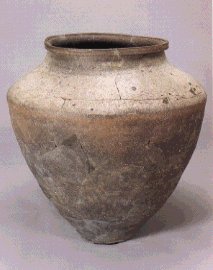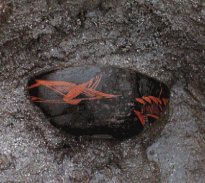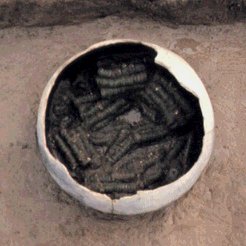Excavated artifacts

A large amount of pottery was discovered at the site. The most common kind of pottery was earthenware. This kind of pottery was excavated from almost all the wells, pits, ditches and ponds. These may have been made in a neighboring village. Pottery from distant place was also used in the town. Some examples are Tokoname and Seto ware from Aichi Prefecture, Bizen and Kameyama ware from Okayama Prefecture. A lot of imported pottery from China, Korea and Vietnam was also discovered at the site. Pottery from distant place must have been brought into this town by ships through the Seto Inland Sea. This indicates that Kusado Sengen was connected to wide regions through the Seto Inland Sea. (Right: Tokoname ware jar)
 Many kinds of wooden objects were discovered. The majority of them were for daily activities such as eating and storing.
Many kinds of wooden objects were discovered. The majority of them were for daily activities such as eating and storing.
Lacquer ware bowls and dishes are regarded as common tableware in the town. These are supposed to be produced in the town because a lot of lacquering tools were excavated from the site. On many of lacquer vessels, there are designs of living things such as birds and plants. These show us sophisticated techniques of lacquering.
Wooden objects used for rituals and games ware excavated. Both the rituals and games practiced by medieval people often arose from their religious lives. These objects are important for understanding the spiritual world of common people in medieval times, which are not recorded in historic sources.
Another kind of important wooden artifacts is wooden tablets with inscriptions. Many of the tables mentioned agricultural products, place names, persons' names and some mentioned money lending to nearby villages. The contents of these inscriptions greatly contribute to understanding of the economy and finance system around Kusado Sengen. (Left: Lacquer ware bowl)
 In medieval Japan, currencies were not issued. People used imported Chinese bronze coins as currency. Clustered and tied coins were sometimes excavated in the site. One example is those deposited in a jar buried in the ground. We made it clear that coin clusters were originally tied to groups of 97 coins. It is likely that 97 was the basic unit of monetary transaction. Those are also important materials tell us how money was circulated and stored. (Left:Coins in the jar)
In medieval Japan, currencies were not issued. People used imported Chinese bronze coins as currency. Clustered and tied coins were sometimes excavated in the site. One example is those deposited in a jar buried in the ground. We made it clear that coin clusters were originally tied to groups of 97 coins. It is likely that 97 was the basic unit of monetary transaction. Those are also important materials tell us how money was circulated and stored. (Left:Coins in the jar)

Carpenters' tools such as a leaf-brade crosscut saw, chisels, gimlets, adzes, wooden mallets and whetstones were excavated. These carpenters' tools were painted in medieval picture scrolls but actual objects were not exist. Together with these tools, marks of carpenters' tools retained on the excavated timber show us the practice of carpentry and the development of carpentry technique during medieval times. (Right: Restored crosscut saw and a chisel)
There are a lot of organic remains such as animal bones, fish bones, fish scales and plant seeds. These gave us evidences telling us what people in the town ate, and what the environment of the town was. For example, many of the dog bones we found show signs of butchering and cooking. Written historic records suggest that Buddhist prohibitions against the eating of meat were in force in medieval times, but the animal remains at the site show that the meat was eaten in quite large quantities.
 back to top
back to top
 next
next 
suzuki-y@mars.dti.ne.jp
Copyright © 1996-1998 Yasuyuki Suzuki & Hiroshima Prefectural Museum of History, Fukuyama, Japan.
Last updated: June 10, 1998.
 Many kinds of wooden objects were discovered. The majority of them were for daily activities such as eating and storing.
Many kinds of wooden objects were discovered. The majority of them were for daily activities such as eating and storing.
 In medieval Japan, currencies were not issued. People used imported Chinese bronze coins as currency. Clustered and tied coins were sometimes excavated in the site. One example is those deposited in a jar buried in the ground. We made it clear that coin clusters were originally tied to groups of 97 coins. It is likely that 97 was the basic unit of monetary transaction. Those are also important materials tell us how money was circulated and stored. (Left:Coins in the jar)
In medieval Japan, currencies were not issued. People used imported Chinese bronze coins as currency. Clustered and tied coins were sometimes excavated in the site. One example is those deposited in a jar buried in the ground. We made it clear that coin clusters were originally tied to groups of 97 coins. It is likely that 97 was the basic unit of monetary transaction. Those are also important materials tell us how money was circulated and stored. (Left:Coins in the jar)
 back to top
back to top
